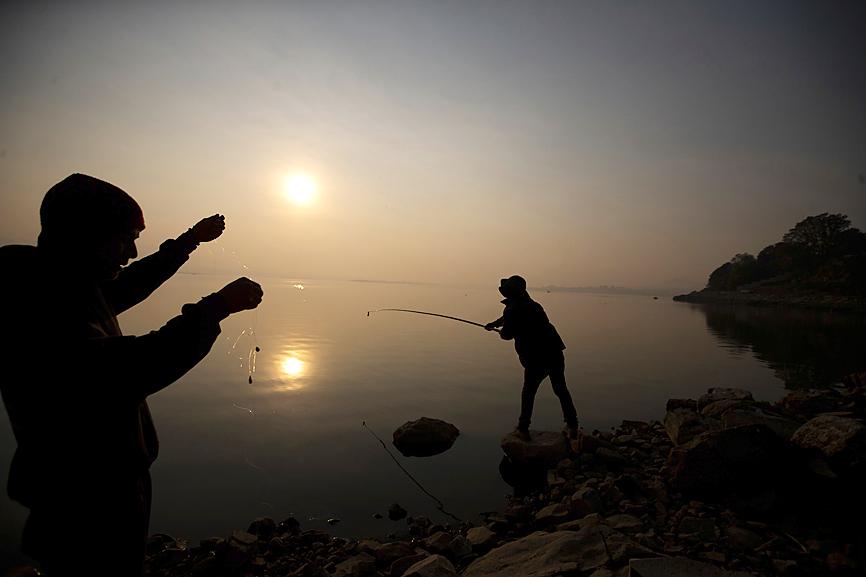About 85 percent of Mexico is affected by water scarcity, and residents of the nation’s central region on Thursday said that lakes and reservoirs are drying up, including the country’s second-largest body of fresh water.
Mexico City Mayor Claudia Sheinbaum said that the scarcity was the worst in 30 years, adding that the problem can be seen at the reservoirs that store water from other states to supply the capital.
Some of them, like the Villa Victoria Reservoir west of the capital, are at one-third of their normal capacity, with a more than a month to go before rain is expected.

Photo: AP
Isaias Salgado, 60, was trying to fill his water tank truck at Villa Victoria, a task that normally takes him 30 minutes. On Thursday he estimated that it was taking more than three hours to pump water into his 10,000-liter tanker.
“The reservoir is drying up,” Salgado said. “If they keep pumping water out, by May it will be completely dry, and the fish will die.”
Sheinbaum said that as the scarcity worsened, more people have tended to water their lawns and gardens, which worsens the problem.
The capital’s 9 million inhabitants rely on reservoirs like Villa Victoria and two others — which on average are at 44 percent of capacity — for one-quarter of their water, with most of the rest coming from wells within city limits.
However, the city’s water table is dropping, and leaky pipes waste much of what is brought into the city.
Rogelio Angeles Hernandez, 61, has been fishing at Villa Victoria for the past 30 years. He is not so much worried about his own catch.
In dry seasons of the past, residents were able to cart fish off in wheelbarrows as water levels receded, he said.
However, tourism at reservoirs further to the west has been affected by falling water levels.
In the end, it is the capital that is most strongly affected.
“Fishing is the same, but the real impact will be on the people in Mexico City, who are going to get less water,” Angeles Hernandez said.
Farther to the west, in Michoacan state, the country is at risk of losing its second-largest lake.
About 75 percent of Lake Cuitzeo is now dry, said Alberto Gomez-Tagle, a biologist and researcher at the University of Michoacan’s Natural Resources Institute.
Deforestation, roads built across the lake and diversion of water for human use have played a role, but three extremely dry years have left the lake a dusty plain, he said.
Michoacan Governor Silvano Aureoles said that so much of the lake has dried up that shoreline communities now experience dust storms.
The communities might have to start planting vegetation on the lake bed to prevent the storms, Aureoles added.

Kehinde Sanni spends his days smoothing out dents and repainting scratched bumpers in a modest autobody shop in Lagos. He has never left Nigeria, yet he speaks glowingly of Burkina Faso military leader Ibrahim Traore. “Nigeria needs someone like Ibrahim Traore of Burkina Faso. He is doing well for his country,” Sanni said. His admiration is shaped by a steady stream of viral videos, memes and social media posts — many misleading or outright false — portraying Traore as a fearless reformer who defied Western powers and reclaimed his country’s dignity. The Burkinabe strongman swept into power following a coup in September 2022

‘FRAGMENTING’: British politics have for a long time been dominated by the Labor Party and the Tories, but polls suggest that Reform now poses a significant challenge Hard-right upstarts Reform UK snatched a parliamentary seat from British Prime Minister Keir Starmer’s Labor Party yesterday in local elections that dealt a blow to the UK’s two establishment parties. Reform, led by anti-immigrant firebrand Nigel Farage, won the by-election in Runcorn and Helsby in northwest England by just six votes, as it picked up gains in other localities, including one mayoralty. The group’s strong showing continues momentum it built up at last year’s general election and appears to confirm a trend that the UK is entering an era of multi-party politics. “For the movement, for the party it’s a very, very big

ENTERTAINMENT: Rio officials have a history of organizing massive concerts on Copacabana Beach, with Madonna’s show drawing about 1.6 million fans last year Lady Gaga on Saturday night gave a free concert in front of 2 million fans who poured onto Copacabana Beach in Rio de Janeiro for the biggest show of her career. “Tonight, we’re making history... Thank you for making history with me,” Lady Gaga told a screaming crowd. The Mother Monster, as she is known, started the show at about 10:10pm local time with her 2011 song Bloody Mary. Cries of joy rose from the tightly packed fans who sang and danced shoulder-to-shoulder on the vast stretch of sand. Concert organizers said 2.1 million people attended the show. Lady Gaga

SUPPORT: The Australian prime minister promised to back Kyiv against Russia’s invasion, saying: ‘That’s my government’s position. It was yesterday. It still is’ Left-leaning Australian Prime Minister Anthony Albanese yesterday basked in his landslide election win, promising a “disciplined, orderly” government to confront cost-of-living pain and tariff turmoil. People clapped as the 62-year-old and his fiancee, Jodie Haydon, who visited his old inner Sydney haunt, Cafe Italia, surrounded by a crowd of jostling photographers and journalists. Albanese’s Labor Party is on course to win at least 83 seats in the 150-member parliament, partial results showed. Opposition leader Peter Dutton’s conservative Liberal-National coalition had just 38 seats, and other parties 12. Another 17 seats were still in doubt. “We will be a disciplined, orderly